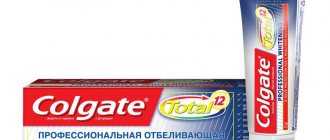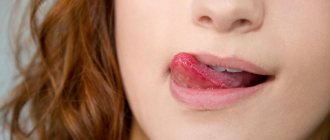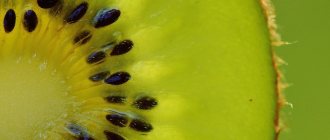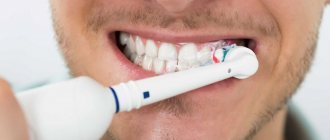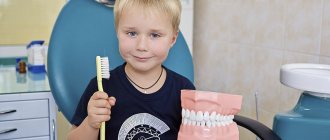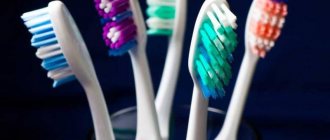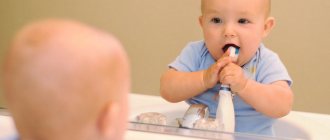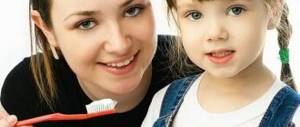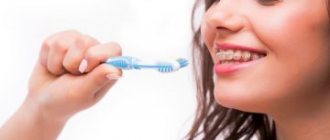An allergy is a hypertrophied immune response of the body to external and internal stimuli. Allergens can include food, dust, animal hair, cosmetics, household chemicals, medications, etc. Allergy to toothpaste is a common phenomenon that many people encounter every day.
It is noteworthy that signs of an immune reaction to a given product are not always localized directly in the mouth area. Thus, characteristic rashes can appear on the skin of the face and neck, mucous membranes; in severe cases, the consequences of the body’s immune response to toothpaste can even affect the functioning of internal organs.
Signs of a toothpaste allergy
- Contact dermatitis. An allergy to toothpaste can manifest itself as rashes in the corners of the mouth and around the lips. If treatment is not started, the disease spreads to other parts of the body.
- Dermatitis on the eyelids. Itching occurs, reddish pimples may appear in the form of acne. This is how the body reacts to fluorides in toothpaste. The rash spreads evenly to the patient’s lips, cheeks, chin and nose.
- Wounds, ulcers. They develop on the oral mucosa and gums. Open wounds cause great discomfort and pain after brushing teeth with toothpaste, eating, or swallowing saliva.
- Cheilitis. It is the most basic symptom of an allergic inflammatory process from toothpaste. Cheilitis is characterized by irritation, dryness and cracking; in advanced conditions, symptoms develop into swelling and purulent discharge.
- Stomach upset . When brushing your teeth, some of the toothpaste enters the gastrointestinal tract. If there is an allergy, the internal organs also begin to react to the disease. From the gastrointestinal tract - this is pain, flatulence, all kinds of disorders.
Other signs when allergy sufferers use toothpaste
- Having difficulty breathing;
- Hives;
- Conjunctivitis;
- Anaphylactic shock;
- Inflammatory process in the gums.
Toothpaste ingredients that cause allergies
Allergic reactions to toothpaste occur mainly due to the body's failure to accept one of the ingredients in the toothpaste. But pain, irritation, etc. can also appear as a result of natural additives, for example, mint.
In addition to the fluoride element, the following substances can stimulate allergies:
- Essential oils, parabens and papain;
- Cocamidopropyl betaine;
- Propylene glycol;
- Sodium benzoate.
Allergies to other foods
If you are prone to allergies to toothpaste, there will be no exception to the tendency to allergic reactions to toothpastes with flavors, mouthwashes, and chewing gum.
Therefore, it is very important to identify which substance in the toothpaste causes an allergic reaction. An allergen can only be identified using special skin tests and allergy tests in a clinic setting.
Causes of allergies
The composition of each paste is strictly individual, but there are still common components. Toothpaste components that cause allergies:
- Essential oils such as eucalyptus and peppermint.
- A group of parabens - methylparaben - can even cause throat cancer.
- Propylene glycol - added to all shampoos and creams.
- Papain.
- Sodium benzonate is a preservative that extends the life of toothpaste.
- Sodium laureate sulfate – provides foaming of the paste composition.
- Bleaching chemical compounds.
- Antibacterial additives.
- Potassium or potassium pyrophosphate.
- Strontium or zinc nitrate.
- Citrate.
- Chloride.
- Triclosan.
Treatment of allergies to toothpaste
It is very important not to ignore the manifestations of negative consequences that appear after brushing your teeth with toothpaste, especially if they began to manifest themselves early. If you notice symptoms of an allergy, you should immediately consult a doctor in order to make a correct diagnosis and begin proper treatment of the allergy.
Methods to prevent toothpaste allergies:
- After introducing toothpaste, you need to carefully rinse your mouth and face, especially in the corners of the mouth.
- Buy a toothpaste that has as few ingredients as possible, or a hypoallergenic toothpaste.
- Avoid introducing products that contain fluoride. Also, do not drink fluoridated water.
- Avoid applying too much toothpaste to your brush to reduce exposure to allergens.
- Try not to swallow the dentifrice.
- You should not give preference to toothpastes with natural ingredients. They may contain rare mixtures of herbs, which can be powerful allergens.
Irritations that are not related to toothpaste allergies
With severe sensitivity of the mouth, after brushing the teeth, symptoms identical to an allergic reaction may appear.
If you often change toothpastes, and the inflammatory process still occurs, your face will show all signs of irritation that are not related to allergies.
In such cases, dentists recommend using certain brands of toothpastes with a minimum content of flavoring additives and oils.
For people with sensitive teeth and gums, it is recommended to use the following brands: Sensodyne, Oral-B, Sensitive Advantage. Also, do not press the brush too hard on your teeth. Buy a toothbrush with medium-spectrum soft bristles.
Toothpaste allergy medications
The pharmacological industry currently produces a fairly extensive list of drugs that are available without prescriptions, but they should only be used after a visit to the doctor.
The most effective remedies for toothpaste allergies include:
- Enterosorbents;
- Telfast;
- Diazolin;
- Claritin;
- Diphenhydramine;
- Tavegil and many others.
They are produced in the form of: tablets, sprays, aerosols, drops (eye and oral) and syrups.
allerganesth.org
Solution
How to cope with the consequences of the body's allergic response to toothpaste: the best thing is to seek help from a dentist, who will determine the allergen that caused the reaction and select the correct complex therapy. Usually, to combat the consequences of allergies, drugs are used - enterosorbents and, of course, antihistamines (Diazolin, Telfast, Claritin, Diphenhydramine, Tavegil). The dosage and type of medications are selected by the doctor.
Symptomatic therapy for an allergic reaction to toothpaste:
- local anti-inflammatory drugs (ointments, gels, aerosols) - Cholisal, Actovegin, Kamistad-gel.
- Antiseptics for treating mucous membranes (Miramistin).
- Vitamin A, sea buckthorn oil and other agents that accelerate wound healing.
- In cases of severe pain and increased body temperature, patients are prescribed analgesics (Paracetamol, Ibuprofen).
- Vitamin complexes to combat immune dysfunction (Alphabet, Undevit).
Important! To combat local allergy symptoms, it is advisable to use Metrogyl Denta paste, a drug with antiseptic, anti-inflammatory, antihistamine and wound-healing properties. This remedy is applied to wounds (ulcers) on the mucous membrane 2-3 times a day until they completely disappear.
Dentists say that improper use of dental floss and mouth rinses can also lead to rashes, irritation of the mucous membranes and cause inflammation of the gums
For allergy symptoms from the gastrointestinal tract, you can use proven folk recipes:
- pomegranate juice copes well with diarrhea, nausea, abdominal pain and other discomfort in the digestive tract;
- You can make this healthy cocktail at home: 1 tbsp. l. mix tomato juice with 1 tsp. ginger, add ½ tsp. salt and lemon juice. This remedy will help to get rid of allergic manifestations as soon as possible, improve well-being, and restore the functioning of the gastrointestinal tract.
Clinical researches
Asept toothpastes and rinses are clinically proven effective. For example:
- Repeated clinical studies have proven that using ASEPTA propolis gum gel for a week can reduce gum inflammation by 31%.
- It has been clinically proven that regular use of professional toothpaste ASEPTA REMINERALIZATION after 4 weeks improved the condition of the enamel by 64% and reduced tooth sensitivity by 66%.
- Repeated clinical studies have proven that the two-component mouth rinse ASEPTA ACTIVE more effectively combats the causes of inflammation and bleeding compared to single-component rinses - it reduces inflammation by 41% and reduces bleeding gums by 43%.
Sources:
- The effectiveness of the use of Asept “adhesive balm” and Asept “gel with propolis” in the treatment of chronic generalized periodontitis and gingivitis in the acute stage (Municipal Dental Clinic No. 4, Bryansk, Kaminskaya T. M. Head of the therapeutic department Kaminskaya Tatyana Mikhailovna MUZ City Dental Clinic No. 4, Bryansk
- Report on the determination/confirmation of the preventive properties of personal oral hygiene products “ASEPTA PLUS” Remineralization doctor-researcher A.A. Leontyev, head Department of Preventive Dentistry, Doctor of Medical Sciences, Professor S.B. Ulitovsky First St. Petersburg State Medical University named after. acad. I.P. Pavlova, Department of Preventive Dentistry
- The role of anti-inflammatory rinse in the treatment of periodontal diseases (L.Yu. Orekhova, A.A. Leontyev, S.B. Ulitovsky) L.Yu. OREKHOVA, Doctor of Medical Sciences, Prof., Head of Department; A.A. LEONTIEV, dentist; S.B. ULITOVSKY, Doctor of Medical Sciences, Prof. Department of Therapeutic Dentistry of St. Petersburg State Medical University named after. acad. I. P. Pavlova
How does the disease manifest itself?
An allergy to toothpaste does not necessarily have to manifest itself directly in the mouth; the symptoms of the pathological process can be localized much more widely and spread to the skin, mucous membranes and even the internal organs of a person. Clinical manifestations can develop either instantly or after some time. So, the main symptoms of an allergy to toothpaste include:
- contact dermatitis, where the allergic reaction manifests itself in the form of rashes in the mouth area, that is, around the lips and in the corners of the mouth. The disease requires immediate treatment, otherwise the allergy will spread to other parts of the body;
- dermatitis on the eyelids, where an allergy to toothpaste manifests itself in the form of itching and red pimples. These symptoms may be acne-like, so the body reacts to fluorides, which may be contained in a hygiene product. If no action is taken, the rash will spread to the cheeks, lips, and chin. What this pathological process looks like can be seen in the photo below;
- ulcers and wounds are localized on the mucous membranes of the mouth and gums. Open forms of wounds give the patient a lot of discomfort and unpleasant sensations, especially after brushing teeth, eating and even swallowing saliva;
- Cheilitis is the main symptom of a toothpaste allergy and is characterized by mouth cracking, dryness and irritation. If left untreated, the process can lead to swelling and purulent discharge. You can see what the symptoms of cheilitis look like in the photo below;
- gastrointestinal disorders. As a rule, when brushing your teeth, a small part of the toothpaste enters the stomach, and if a person is allergic to this product, then, accordingly, the internal organs begin to react. This negative reaction manifests itself as pain, flatulence, disorders such as nausea, diarrhea, and sometimes vomiting.
In addition to the main allergy symptoms listed above, there may be other manifestations in the form of breathing problems, urticaria, conjunctivitis, and inflammation in the gums. In severe cases, anaphylactic shock may develop, which requires immediate hospitalization and professional medical care.
As a rule, an allergy to a toothpaste product occurs due to the body's intolerance to one of its elements. But it is worth noting that unpleasant pain and irritation can also develop from natural supplements in the form of mint. In addition to fluoride, the following can cause an allergic reaction: essential oils, sodium benzoate, parabens, propylene glycol, papain.
Sensodyne
Sensodyne toothpaste is designed to whiten teeth with increased gum sensitivity. It contains 13 components, 4 of them are natural, and 9 are obtained synthetically. Moreover, 5 of the 9 ingredients of the paste are on the packaging itself.
The natural and practically safe components of Sensodin include water, sorbitol, silicon and silicic acid.
Synthetic components and their effects on the body need to be considered in more detail:
- Glycerin. Consists of fat and water, which separates it into fatty acids and glycerol. Glycerin is used as a humectant, but research has shown that Glycerin draws moisture from the lower layers of the skin, not from the air. As a result, this increases the dryness of the mucous membranes and skin, which in turn increases the likelihood of irritation;
- Tetrapotassium Pyrophosphate (K4P2O7). Potassium pyrophosphate is powder or white crystals that dissolve well in water. Used to improve the structure of hygiene and detergents. When inhaled, it irritates the walls of the respiratory tract and has a negative effect on the skin and outer membranes of the eyes. Belongs to the group of components that are dangerous in terms of the development of allergies;
- Cocamidopropyl Betaine. Made from fatty acids derived from coconut oil. In pastes it is used as a surfactant. ABOUT;
- Potassium Chloride (potassium chloride). Regulates the structure of toothpaste. Refers to hazardous components. Can lead to: irritation of the nasopharynx, bronchi, throat when inhaled, vomiting and irritation of the gastrointestinal tract if ingested, disruption of blood flow and weakness, negatively affects the functioning of the heart. In excessive quantities it causes death. Skin and eye irritation – lacrimation, hyperemia.
- Cellulose Gum is a semi-synthetic substance made from cellulose. Binds the main components and stabilizes them, regulates viscosity. A complex of synthetic components that provide the aroma of toothpaste. A. An allergy can occur either to one of the components of the complex or to the smell of the product;
- Sodium fluoride “Sodium Fluoride4. Marked on the packaging as a hazardous component. May be fatal if inhaled in large quantities or if swallowed. Poisoning by fluoride ions is indicated by weakness, nausea, followed by diarrhea and vomiting. If left untreated, the negative effects continue and fluoride affects the nervous, cardiovascular, respiratory and kidney systems. Possible death due to respiratory paralysis. A dangerous dose of sodium fluoride is 5-10 grams; Sensodyne paste contains 0.31 percent of the total composition of this component. Allergies manifest themselves in the form of weakness, nausea, irritation of the mucous membranes;
- Sodium Saccharin is a synthetic sweetener that improves the taste of the paste;
- Titanium dioxide (CI 77891). It is a natural mineral, a white dye.
POPULAR WITH READERS: “Dr. Popovich Center for Allergology and Immunology”
The instructions for use of Sensodyne paste indicate that the effects of the components of the product may not appear immediately. This means that allergies, as well as other dangerous changes in the body when using this product, can occur after several months or even years of trouble-free use of the product.
How to cope with the disease
Naturally, first of all, it is necessary to eliminate the allergen that causes such unpleasant sensations. Therefore, you need to go to a doctor who will help you determine which element of the toothpaste you are allergic to and prescribe the appropriate treatment. The main methods of preventing an allergic reaction include:
- after using this hygiene product, you must rinse your mouth very thoroughly, especially in its corners, and wash your face;
- It would be best to replace your toothpaste with a hypoallergenic one;
- do not consume products containing fluoride, including avoiding drinking fluoridated water;
- try not to apply too much toothpaste to the brush;
- Do not swallow the product while brushing your teeth.
Among drug therapy in the treatment of this type of allergy, the following are used: Enterosorbents, Telfast, Diazolin, Diphenhydramine, Tavegil, Claritin and many others.
allergiyu.ru
Why do jams, spots, rashes and other “charms” appear?
There are several reasons why an allergy to toothpaste occurs. And they all have one common pattern: the immune system’s rejection of the additional components that make up the product.
Here are some of the reasons that most often cause an allergic reaction:
- Foaming - many pastes contain sodium lauryl sulfates. The action of these substances is aimed at increasing foaming. Excessive foam can negatively affect the functioning of the respiratory system.
- Varied taste and aroma - this effect is achieved by adding various flavors, dyes, flavor enhancers, and preservatives. Many of the components listed may cause an allergic reaction.
- The presence of fluoride - this component protects the enamel and restores it through remineralization. Fluoride fights various bacteria, neutralizes putrefactive processes, and prevents the occurrence of caries. But for all its benefits, this is a very aggressive substance, and allergies to fluoride contained in toothpaste are not uncommon.
- Bleach is an abrasive substance that prevents the formation of tartar, just like dyes and flavors can cause a negative reaction in the body.
- Antibacterial additives are products aimed at fighting bacteria. Some of them can cause a response from the body.
- Barrier function – protects sensitive endings from exposure to aggressive environments.
Types of professional care
In modern dentistry, there are several types of professional oral hygiene:
- Mechanical cleaning using special equipment. The doctor uses a machine with rotating brushes or manually removes soft deposits and tartar. Typically, hand tools are used for areas that cannot be reached with apparatus. Despite the low price, this procedure is not popular, as there is a high risk of injury to the gums.
- Sandblasting involves the use of devices with which the doctor removes pigmented and mineralized plaque from the surface of the teeth. Using a unit, the doctor directs a stream of water with dissolved soda onto the teeth. Since the device nozzle does not come into contact with the treated area, the risk of injury to enamel and soft tissue is eliminated. The method of professional oral care is suitable even for those with damaged teeth. After removing the plaque, the doctor polishes the tooth enamel.
- Ultrasonic cleaning. Plaque is removed using a special device, which, emitting vibrations of a certain frequency, acts on the boundary that separates tartar and tooth tissue. This type of cleaning makes it possible to remove dental plaque above and below the gums and is used as an additional sanitation of the oral cavity.
- Laser cleaning. In recent years, this type of professional hygiene has become more popular. The beam removes tartar from the teeth, eliminates the yellowness of the smile, removes pathogenic bacteria and does not injure the tissue surrounding the bones.
Causes
Contact with synthetic substances in toothpaste is a factor that provokes redness of tissues, the appearance of ulcers, wounds, rashes, and cracking of the mucous membrane. Allergic inflammation develops when histamine actively enters the bloodstream, when the stability of mast cells is disrupted, and the sensitivity of peripheral receptors increases.
The main allergens in toothpaste:
- propylene glycol;
- papain;
- sodium benzoate;
- parabens;
- fluorides;
- essential oils;
- cocamidopropyl betaine;
- dyes and fragrances;
- rarely - natural supplements (citrus, eucalyptus or mint extract).
Allergy to toothpaste ICD code – 10 – T66 – T78 (section “Other and unspecified effects of external causes”).
How to recognize allergic bronchospasm and how to provide first aid? We have the answer! Instructions for using Zaditen eye drops for allergic reactions are described in this article.
Causes of allergic stomatitis
Allergic reactions in a person can appear at any age, even if there have been no such reactions to pollen, plants, medications, etc. before. was not observed. The manifestation of this kind of reaction may be associated with genetic changes in the body and malfunctions of the immune system. Blood cells, which are responsible for the formation of antibodies to various pathogenic bacteria and viruses, at a certain point begin to react to a substance that has entered the body as an “enemy”, as a result of which a typical allergy appears.
Allergic reaction - how to identify and stop the process?
Doctors have proven that an allergic reaction is the result of a malfunction of the immune system. Therefore, the symptoms of the disease can not only be external (manifestations of allergies on the skin or mucous membranes), but can also spread to internal organs.
There are several characteristic signs that indicate an allergy to toothpaste:
- The development of dermatitis on the lips and the appearance of sticking in the corners of the mouth . Timely treatment and prevention will prevent the disorder from spreading to other organs.
- The occurrence of dermatitis in the eyelid area . The disease has the appearance of a pinpoint rash, reminiscent of acne. Without proper treatment, the rash can move to the lips, nose, chin, and cheeks.
- Manifestation of a negative reaction in the form of wounds and ulcers in the mouth . This condition is accompanied by severe painful sensations that occur precisely after brushing your teeth or eating.
- Redness of the mucous membranes with increased dryness, which causes the formation of cracks . In a neglected state, the formation of edema in the form of ulcers is possible.
- Gastrointestinal disorder . This reaction is possible if toothpaste gets into the digestive system if a person is predisposed to allergic reactions.
- Disruption of the respiratory cycle occurs due to pulmonary edema . This is an allergic response of the body. In severe form, it can lead to the development of Quincke's edema or anaphylactic shock.
Symptoms
An allergy to a dentifrice does not only have external signs; often the symptoms also affect internal organs. The defense system also suffers, which causes serious deviations in the functioning of the entire body. In this case, allergies can begin quickly or intensify gradually as harmful substances accumulate.
Symptoms of a toothpaste allergy
Contact dermatitis. In this case, a rash appears around the mouth and seizures in the corners. In the absence of effective treatment, unpleasant symptoms can spread throughout the body. Itching and rash may occur, affecting not only the area of direct contact with the paste, but also the nose, cheeks, and chin.- Formation of wounds on the mucous surfaces of the mouth and gums. Such areas are characterized by soreness, which increases after brushing teeth and eating. An allergy to toothpaste in a child is especially dangerous, since children cannot accurately describe what and where it hurts, they simply behave restlessly and are capricious.
- Inflammation of the lips (cheilitis) in which the skin becomes pale, dry and cracked. In advanced situations, there is a risk of swelling and purulent discharge.
- Intestinal manifestations. Since a small amount of toothpaste can enter the gastrointestinal tract, the allergy also affects internal organs. In this case, the pathological reaction is characterized by burning pain, bloating, frustration, exacerbation of chronic gastritis, and so on.
- Problems with the respiratory system, which often accompany allergic reactions. Severe swelling of the larynx, tongue, cheeks can cause deterioration in air flow. If left untreated, there is a high likelihood of developing angioedema and anaphylaxis.
Along with specific symptoms, an allergy to dental care products can also be accompanied by general symptoms, such as hyperthermia, sleep disturbance, and fatigue.
Features of manifestation in children
Despite the fact that the symptoms of an allergy to toothpaste are similar in childhood and in adults, sometimes the child’s body reacts specifically to the components of the product. In this case, the pathological reaction is accompanied not only by rashes, itching and hyperemia, but also by general malaise. The main signs of allergies in children are:
- severe redness on the face;
- burning in the mouth;
- drowsiness, lethargy;
- fatigue, moodiness;
- upset stool, nausea;
- moderate hyperthermia;
- inflammation of the mucous membrane and skin around the mouth.
Treatment of allergic stomatitis
For conditions such as allergic stomatitis, comprehensive treatment is necessary. If a reaction to dentures occurs, the effect of the allergen should be excluded (i.e., stop wearing dentures), and measures must also be taken to prevent the development of the disease in the future (densture replacement). The patient must follow a diet that includes the required amount of microelements and vitamins; spicy, salty, sour foods and foods that provoke allergies (eggs, coffee, strawberries, citrus fruits, etc.) should be completely excluded. You should also stop drinking mineral water.
The main principle of treating allergic stomatitis is to eliminate contact or consumption of the allergen as quickly as possible. In case of various kinds of unpleasant sensations in the oral cavity (itching, burning, pain, swelling, redness, rashes, etc.), you need to see a dentist, who will help determine the cause of the irritation, prescribe effective treatment, and, if necessary, refer you to other specialists (endocrinologist, therapist etc.).
Typically, in the treatment of allergic stomatitis, antihistamines (clarotadin, suprasin, fenistil, etc.) are used together with vitamins B, C, PP, and folic acid. Inflamed areas of the oral mucosa are treated with antiseptic, analgesic, healing solutions and agents (Actovegin, Kamistad, sea buckthorn oil, etc.).
Treatment of allergic stomatitis in children
Allergic stomatitis in children, as well as in adults, is usually a general reaction of the body to an allergen. Oral irritation is the result of the interaction of the body's antibodies with allergic particles. Treatment should be aimed at quickly identifying the allergen and eliminating it. If you have a drug allergy, you should avoid taking the medication; if you are allergic to certain foods, you should avoid consuming these foods; if your body reacts to the composition of the fillings, you should contact your dentist and have the filling replaced.
The oral cavity must be rinsed with special antiseptics, preferably having an analgesic effect (lysozyme, methenamine with novocaine, etc.). The ulcers can be cauterized with aniline dyes or a mixture of antibiotic and vitamin B1 can be applied.
How to prevent and stop a negative reaction?
At the first sign of an allergy, you should completely stop using your toothpaste. If you know what specific substances give such a reaction, then you need to buy a new one, without them in the composition, but if you were unable to identify the irritating components yourself, you should take tests to identify them. In any case, going to the doctor should be mandatory.
The doctor will prescribe antihistamines, such as Telfast, Diazolin, Claritin, Tavegil, Zyrtek, etc. Activated carbon, Filtrum or Enterosgel will help to enhance the effect and remove the toxic substance.
Before visiting the dentist's office, you need to do some things that will help alleviate the painful condition or even get rid of negative consequences:
- After each brushing of your teeth, you must rinse your mouth thoroughly to remove as much toothpaste as possible;
- choose a hypoallergenic paste or a product with a minimum set of different ingredients;
- stop using toothpaste containing fluoride, and also stop drinking fluoridated water;
- To brush your teeth, apply a minimal amount of product to the brush to reduce exposure to allergens;
- When brushing your teeth, try not to swallow the toothpaste.
What to do during an acute attack and how to treat it
If you have an acute attack, you need to take the following drugs that have a minimum number of side effects: Telfast, Diphenhydramine, Claritin, Tavegil, Filtrum.
If the allergy affects the gastrointestinal tract, then medications should be used:
- Enterosgel. The drug quickly relieves pain and restores the gastric mucosa.
- Activated carbon. The absorbent removes all toxic substances from the body.
In order to prevent the attack from happening again, you should strictly follow the recommendations of experienced doctors: use hypoallergenic paste when brushing your teeth, do not swallow the paste, do not apply too much paste to the toothbrush, rinse your mouth thoroughly, avoid the use of fluoride, as in products nutrition and in cosmetics.
Choosing a hypoallergenic hygiene product
The purpose of using toothpaste is to remove plaque. To do this, use abrasive substances calcium carbonate or sodium bicarbonate.
They are very aggressive and can cause allergies. Therefore, it is better to give preference to a product based on titanium dioxide or silicon.
In some regions, the fluoride content in water does not reach the required levels, so doctors recommend replenishing the deficiency of this element using fluoride-containing pastes. But it is better to give preference to fluorine in organic form. In this case, the manufacturer indicates aminofluoride or olaflur on the packaging.
It is better to choose a product without taste or color, since dyes and preservatives can be harmful to use. It is better to use natural ingredients as a thickener: pectin, resins, agar-agar. To improve taste and freshness, mint, menthol, and vanillin are preferable natural flavoring additives.
Hypoallergenic toothpastes:
- Splat Zero Balance . Hypoallergenic paste, does not contain flavors, preservatives, dyes, essential oils, phosphates, fluorine. The active components are presented in the form of Perilla seed extract, Lysozyme enzymes, silver ions, arginine.
- ROCS . All hygiene products from this manufacturer have an abrasive effect on the one hand, and a pronounced therapeutic effect on the other. Does not contain preservatives.
- Century East . This oral hygiene product actively fights bleeding gums, is intended for daily use, and prevents caries. These properties are possible due to the presence of medicinal herbs and oils in the extracts. Anti-inflammatory and antibacterial properties are effective for the prevention and treatment of periodontal disease, stomatitis, and halitosis.
dentazone.ru
Can fluoride provoke severe and hereditary diseases?
Scientists were able to find a relationship between water fluoridation and a 30% increase in the level of thyroid pathologies. Another analysis suggests that 2-5 mg of fluoride consumed over several months does lead to hypothyroidism.
It is a fact that toxic substances negatively affect our health, and by receiving doses of such substances in the form of pesticides in food or in water and air, we significantly increase the risk of irreversible consequences for our brain activity.
Excess of the substance destroys tooth enamel and bone structure. WHO states that fluoride levels above 1.5 mg per liter lead to crumbling of tooth enamel and deposits on bones. Values above 10 mg per liter threaten disability due to fluorosis.
Fluoride can also accumulate in large quantities in the pineal gland. This gland in the brain synthesizes and produces melatonin. The hormone is known as the basis for a drug to help you fall asleep quickly, but few people know that it also determines the onset of puberty in girls, which has become much younger over the past decade. Fluoride in water and in oral care is becoming a key factor in serious diseases, especially against the backdrop of a worsening environmental situation.
Treatment
It is not so difficult to identify an allergen using an examination. One of the mandatory points in treatment is visiting a doctor for consultation and prescribing further treatment.
The point is that you need to identify what substance your body is reacting negatively to. Try to apply as little toothpaste as possible to your brush and purchase a hypoallergenic toothpaste.
Rinse your mouth after any contact with toothpaste. Do not use products that contain fluoride. Treatment should be started as soon as you notice allergy symptoms. The following drugs will help you in treatment: Diphenhydramine, Telfast, Claritin. Use traditional methods - this is also one of the most powerful remedies for allergies.
Method of use of the drug "Telfast"
Method of use of the drug "Claritin"
Features of the symptomatic picture in children
Children's toothpaste does not always guarantee that your child will not have allergies. Typically, children have an allergic reaction to a component called Limonene . It is the prototype of citric acid found in fruits.
The danger of allergies in children is that it can provoke a number of inflammatory diseases of the mouth and throat, chronic urticaria, asthma, and sometimes, in the absence of timely help, an attack of suffocation can lead to death.
Who needs professional oral care?
To all patients. It is important to understand that daily self-brushing of teeth does not allow you to 100% get rid of deposits that are dangerous to oral health. Even properly selected tools and pastes remove approximately 60% of soft plaque.
On the enamel under the gingival margin, on the back side of crowns, and on the side surfaces of teeth, deposits and accumulations of microbes remain, which very quickly turn into tartar. It is impossible to remove these hard deposits on your own, and to maintain the health of your teeth and gums, it is important to regularly seek professional teeth cleaning from your dentist.
Regular professional oral care is especially necessary:
- smokers;
- patients who violate daily oral hygiene;
- patients with pathologies in the structure of the dentition and disorders in chewing food and swallowing;
- patients with braces, dentures and other artificial structures in the mouth.
If tartar begins to be deposited and accumulates in periodontal pockets, the risk of periodontitis and, accordingly, tooth loss will significantly increase. Therefore, each of us needs to undergo regular dental examinations so that the doctor promptly identifies problems in the oral cavity and prescribes cleaning.
Professional teeth cleaning allows you to:
- 100% remove both soft and already hardened plaque from the enamel surface;
- polish the enamel so that plaque accumulates on the teeth more slowly and is easier to remove when brushing;
- remove stains and plaque from the gums, lighten the enamel and restore aesthetics to your smile;
- reduce the risk of caries, bleeding gums, gingivitis, stomatitis and other dental and periodontal diseases;
- strengthen tooth enamel.
It is especially important to regularly have professional teeth and gum cleaning for patients who have a tendency to develop plaque on their enamel, as well as for people predisposed to periodontal disease.
In addition, the presence of tartar is almost always a contraindication to prosthetics, installation of braces and implants. Therefore, dentists often prescribe such a mandatory procedure to patients before starting treatment.
Folk remedies
- To reduce itching in the mouth, you need to drink a tincture of dill and water, after leaving it in a thermos for five hours.
- If skin dermatitis occurs, take baths with herbal decoction for 15 minutes at least three times a week.
- Wipe your skin with apple compresses.
- Take more vitamin C to boost your immunity.
- Prepare a mixture of duckweed and water, wipe the affected areas of the skin with it twice a day.
- Another good way to reduce itching is sour cream. Apply it to redness and massage the skin with gentle movements. This procedure is necessary for the skin three or four times a week.
- A decoction of elecampane helps reduce itching. Boil this mixture for 10 minutes over a fire and take one tablespoon at least three times a day.
